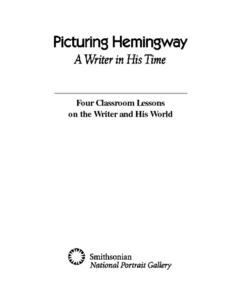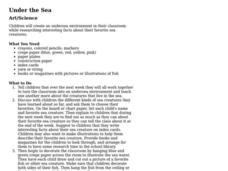NOAA
What Little Herc Saw
See the underwater world through a different pair of eyes! Middle school marine biologists identify deep-sea organisms by examining images taken by an ROV from the Okeanos Explorer. After determining what creatures lie beneath the...
Curated OER
Dead Sea Investigation: Middle East and African Connections
Students demonstrate comprehension of the physical characteristics of the Dead Sea region and its connection to the Red Sea and the African Great Rift Valley. They are given students the opportunity to understand the role of plate...
Curated OER
Bioluminescence 2009: Living Light on the Deep Sea Floor Expedition - Now You See Me, Now You Don't
Students examine bioluminescence and camouflage of deep sea creatures. In this deep sea creatures instructional activity, students investigate the visible and near-visible light spectrum. They work in small groups to complete a light,...
Curated OER
Turtle Hospital
Students explore techniques to rescue and rehabilitation of stranded and injured sea turtles. They examine the turtle's impact on the environment. Students discuss ideas to reduce the number of stranded marine turtles.
Curated OER
Changing Planet: The Case of the Leaky Gyre
The fascinating video "Changing Planet: Fresh Water in the Arctic," introduces your oceanographers to the world's gyres. They learn that melting sea ice is making the gyres larger, and that the changes could, in turn, contribute even...
Consortium for Ocean Science Exploration and Engagement (COSEE)
Life in an Ocean World
How does the shell color of crabs and the habitat they live in impact the predator-prey relationship? The fourth activity in a series of five is a game where participants try not to get eaten if they are a prey and try to eat if they are...
Curated OER
Now You See Me, Now You Don't
Bioluminescence fascinates most upper elementary scientists. Display images of different glowing deep-sea organisms and discuss their environment. Young biologists then experiment with images and different colors of filtered light. In...
Discovery of Sound in the Sea
How to Build a Hydrophone
The materials and procedures for building a hydrophone, an underwater sound collecting device, are provided in this resource. Have high school oceanographers construct the underwater microphone to pick up sound waves. Then take them out...
NOAA
Deep-Sea Ecosystems – Chemosynthesis for the Classroom
Photosynthesis was discovered in the 1770s, but chemosynthesis wasn't discovered until 1977. While many have performed an experiment to show how photosynthesis works, the activity allows pupils to observe chemosynthesis. Scholars set up...
Curated OER
SOS!
Students examine natural and man-made threats to sea turtles. They create sea turtle mobiles while studying the range, environment, predators of and threats to sea turtles.
Curated OER
Picturing Hemingway: A Writer in His Time
Designed to support a visit to the Smithsonian National Portrait Gallery exhibition “Picturing Hemingway: A Writer in His Time,” which ran from June 18, 1999 through January 2, 2000, the approach detailed and the activities included in...
Curated OER
Biocomplexity Lab Activity: Density and Buoyancy of
Pupils investigate how the density of water changes the buoyancy of
water. Students create a hypothesis about what will happen when placing the
egg into the water.Pupils can research online different bodies of water (The Red Sea, The...
Curated OER
A Funny Taste
Students participate in a demonstration that illustrates the relative amounts of salt in various bodies of water including the Dead Sea, Sallt Lake, Ocean water and distilled water. They taste and compare various mixtures.
Consortium for Ocean Science Exploration and Engagement (COSEE)
Life Cycle of Blue King Crabs
The blue king crab and the red king crab live in the same range but never in the same region. The third lesson in the series of five focuses on the blue king crab and the impact the changes in water temperature is having on its habitat....
Curated OER
Coral Mania
Students examine deep-sea coral. In this coral lesson, students identify the structure and function of a coral polyp. Students then create a model of a coral polyp.
Curated OER
Moses and the Ten Commandments
Students watch a video about Moses and the Ten Commandments; participate in discussion; create a replica table of the Ten Commandments, or create a picture illustrating the parting of the Red Sea.
Curated OER
The Hunt for Red October
Ninth graders identify and apply some of the vocabulary used in Science concerning the Sea Perch project. They view a video of The Hunt for Red October, and students make a comparative study of the translation of the printed work onto...
Curated OER
Chemosynthesis for the Classroom
Explorers set up Windogradsky columns with local mud so that they can culture microorganisms. After three and six weeks they make observations of the mud and the organisms growing in it. In this way they observe succession and relate...
NOAA
Where Have All the Glaciers Gone?
What happens when ice melts? Well ... water happens. When that melting ice is a glacier, the amount of water that results produces change throughout the world. Middle school science sleuths uncover the truth about global warming, the...
NOAA
Animals of the Fire Ice
When the sun's rays can't reach the producers in a food web, where does all the energy come from? Extreme environments call for extreme food sources. Young scientists investigate creatures that appear to get their energy from methane...
Curated OER
World War II
Sixth graders read Under the Blood Red Sun (UBRS), V is for Victory (V), and Number the Stars(NS). They examine WWII through the eyes of Japanese, Danish, and American students and complete at least two projects: a radio broadcast and a...
Curated OER
Something Fishy Going On
Students create a video animation of how Swimmy gathered his fish friends together to form a great big fish that would frighten the predator tuna away. In art class each child create a small red fish which gets displayed in the ocean...
Curated OER
What's Bright Red and Invisible?
Students study that very little sunlight penetrates the ocean below depths of 200 meters. They study that no light penetrates the ocean below depths of 1000 meters. They study that the quality of light changes as depth increase
Curated OER
Under the Sea
Students create an undersea environment in their classroom while researching interesting facts about their favorite sea creatures. They create illustrations to decorate their classroom and transform it into an undersea environment.
Other popular searches
- Moses Red Sea
- Red Sea Urchin
- Red Sea Religion
- Density Red Sea
- Red Sea and Buoyancy
- Red Sea Map
- The Red Sea
- Red Sea Urchin"
- Giant Red Sea Urchin
- Parting Red Sea

























